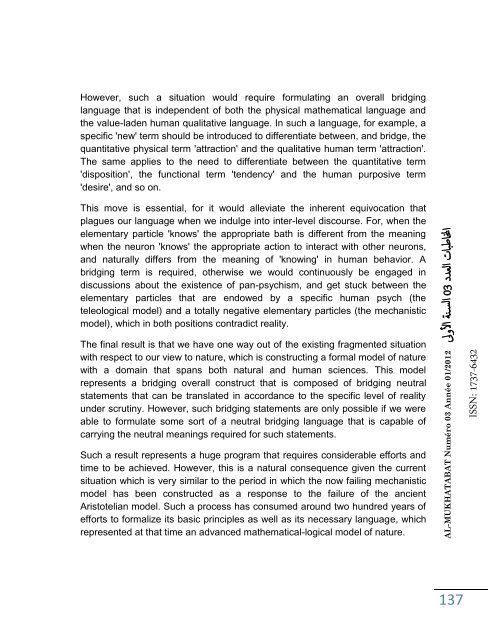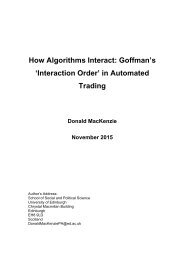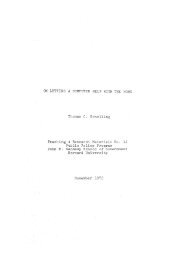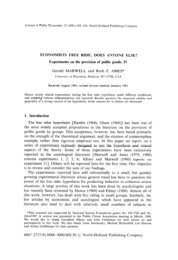n3-al-mukhatabat-journal
n3-al-mukhatabat-journal
n3-al-mukhatabat-journal
Create successful ePaper yourself
Turn your PDF publications into a flip-book with our unique Google optimized e-Paper software.
However, such a situation would require formulating an over<strong>al</strong>l bridging<br />
language that is independent of both the physic<strong>al</strong> mathematic<strong>al</strong> language and<br />
the v<strong>al</strong>ue-laden human qu<strong>al</strong>itative language. In such a language, for example, a<br />
specific 'new' term should be introduced to differentiate between, and bridge, the<br />
quantitative physic<strong>al</strong> term 'attraction' and the qu<strong>al</strong>itative human term 'attraction'.<br />
The same applies to the need to differentiate between the quantitative term<br />
'disposition', the function<strong>al</strong> term 'tendency' and the human purposive term<br />
'desire', and so on.<br />
This move is essenti<strong>al</strong>, for it would <strong>al</strong>leviate the inherent equivocation that<br />
plagues our language when we indulge into inter-level discourse. For, when the<br />
elementary particle 'knows' the appropriate bath is different from the meaning<br />
when the neuron 'knows' the appropriate action to interact with other neurons,<br />
and natur<strong>al</strong>ly differs from the meaning of 'knowing' in human behavior. A<br />
bridging term is required, otherwise we would continuously be engaged in<br />
discussions about the existence of pan-psychism, and get stuck between the<br />
elementary particles that are endowed by a specific human psych (the<br />
teleologic<strong>al</strong> model) and a tot<strong>al</strong>ly negative elementary particles (the mechanistic<br />
model), which in both positions contradict re<strong>al</strong>ity.<br />
The fin<strong>al</strong> result is that we have one way out of the existing fragmented situation<br />
with respect to our view to nature, which is constructing a form<strong>al</strong> model of nature<br />
with a domain that spans both natur<strong>al</strong> and human sciences. This model<br />
represents a bridging over<strong>al</strong>l construct that is composed of bridging neutr<strong>al</strong><br />
statements that can be translated in accordance to the specific level of re<strong>al</strong>ity<br />
under scrutiny. However, such bridging statements are only possible if we were<br />
able to formulate some sort of a neutr<strong>al</strong> bridging language that is capable of<br />
carrying the neutr<strong>al</strong> meanings required for such statements.<br />
Such a result represents a huge program that requires considerable efforts and<br />
time to be achieved. However, this is a natur<strong>al</strong> consequence given the current<br />
situation which is very similar to the period in which the now failing mechanistic<br />
model has been constructed as a response to the failure of the ancient<br />
Aristotelian model. Such a process has consumed around two hundred years of<br />
efforts to form<strong>al</strong>ize its basic principles as well as its necessary language, which<br />
represented at that time an advanced mathematic<strong>al</strong>-logic<strong>al</strong> model of nature.<br />
AL-MUKHATABAT Numéro 03 Année 01/2012 لىولأا ةن سلا 30 ددعلا تابطانا<br />
137<br />
ISSN: 1737-6432







